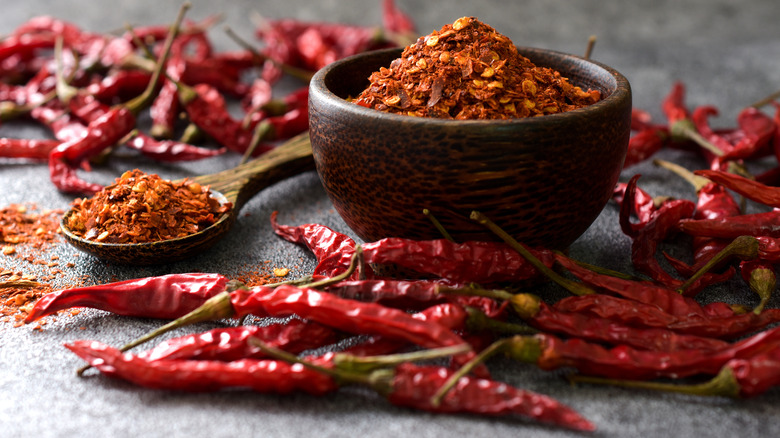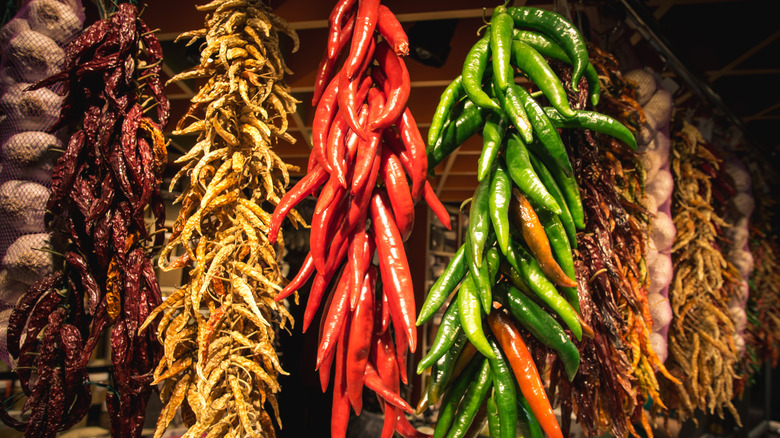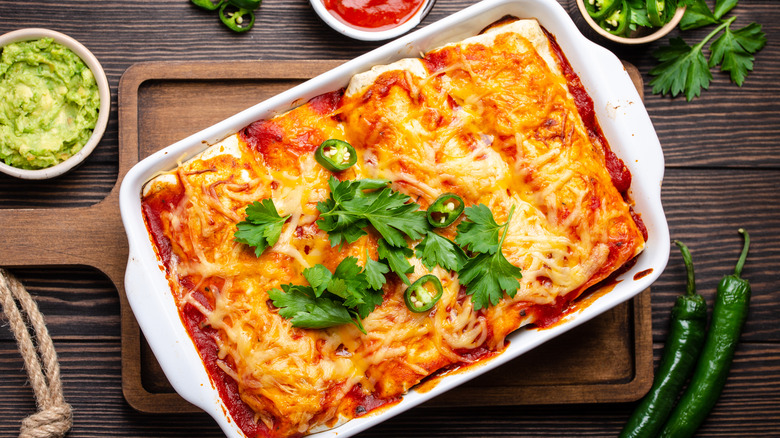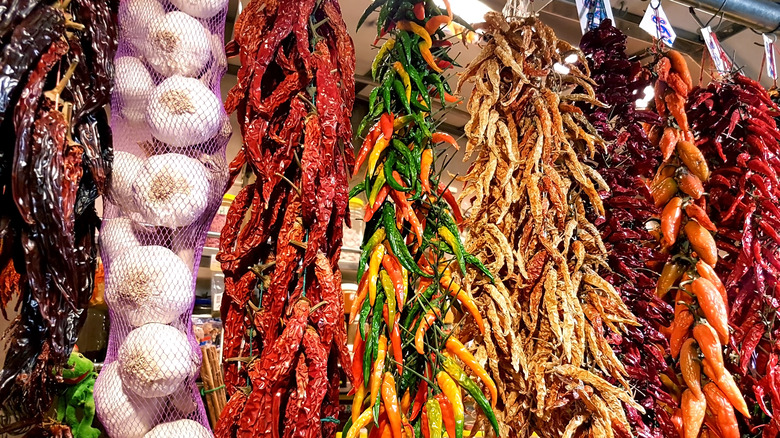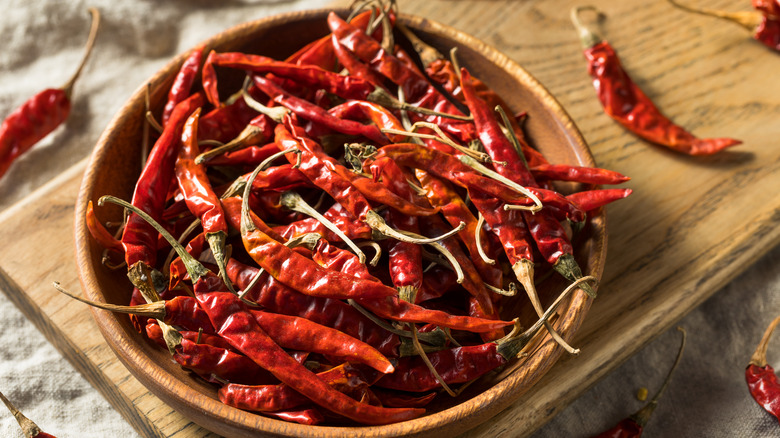What Are Dried Chili Peppers And How Hot Are They?
Mexican chiles — capsicum annuum — are the backbone of some of the most flavorful dishes, and they come from capsicum pepper plants. They're actually related to bell peppers and tomatoes. You may just think of serrano or poblano peppers, but dried chiles give that extra oomph you wouldn't get otherwise. This is why you will see an array of dried chiles just painting the wall at a Mexican market, per Saveur.
When you think of fresh peppers, you think of the crunch as well as the different colors and heat they can bring to dishes. But it's the dried version that truly transforms the entire meal by adding a complex range of flavors. In fact, they have flavor profiles that are mild, sweet, and incredibly spicy (via Saveur).
The variety of dried chili peppers just furthers their popularity. If you have ever had Mexican style dishes that have a sauce, a stew, or soup involved, there was a strong possibility that you tasted the wonderful flavors of dried chili peppers (via Saveur).
How hot are dried chili peppers?
Since there are different varieties of chile peppers, the heat levels are going to change. Six common dried chiles are ancho and mulato, chiles de arbol and chiles secos, chipotle, pasilla, and pequín, per The Spruce Eats. However, the heat between dried and fresh peppers may be similar.
While both dried or fresh can be equally hot, there is science behind the real answer of which is hotter. Capsaicin is an alkaloid compound and is the reason hot peppers are, well, hot. The higher the concentration, the hotter the chili, per PepperScale.
The concentration of capsaicin is higher in dried chiles since they tend to be more ripe than fresh chiles (via PepperScale). Different kinds of chiles will also have different levels of heat.
Heat is measured by using the Scoville heat unit scale (SHU). Jalapeño peppers have an SHU of 5,000, and mulato chile is about half as hot, but is still hotter than an ancho chile. Chiles de arbol is between 15,000 and 30,000 SHU. Chipotle chiles are between 5,000 and 10,000 SHU. Pasilla chiles are between 1,000 and 2,000, and pequín chiles are incredibly hot at around 40,000 to 60,000 SHU, per The Spruce Eats.
How to cook with them
If the heat didn't scare you off, let's delve into how you can cook with these hotties. As you now know, there is a lot to pick from. So, it is good to know which ones are best for what, that way you can master some authentic Mexican cuisines.
Starting off with ancho and mulato, these pretty hot chile peppers are best when thrown into sauces such as one for enchiladas (via The Spruce Eats). For these, you'll want to soak them in boiling water, then remove the seeds and cut them into pieces. You'll then just mix them with other ingredients like water, garlic, onion, dried oregano, and cumin.
Per The Spruce Eats, chiles de arbol and Chile secos are very similar in the way they are cooked and are usually added into stews, soups, or sauces to add flavor and heat. Chipotle chiles are often used more because they come dried, but are sold in cans as well, which is convenient. In fact, they are a main ingredient in adobo sauce.
Pasilla chiles can be hot, but not nearly as hot as the others. Since they are more subtle, throwing them into a stew or rich sauce will add a flavor that helps balance out the dish. You can also stuff them with cheese! Lastly, we have the mega hot pequín chiles and because they are so hot, adding them into a sauce or stew is the best way to enjoy their heat without overdoing it.
How do you dry chiles?
If you are interested in learning how to dry these yourself, it is actually a pretty simple process! Granted, you can buy dried chile peppers at grocery stores or a Mexican grocery store easily. Whichever way you choose, there is a good mix of options.
Pick up some fresh chiles from the store — any kind you want. Once home, simply remove all the dirt with water and pat them dry. You can either place them on a plate or wire rack in a dry and well-ventilated area, or you can string them up to dry. This is not an overnight process, however. In fact, it can take weeks, per Chili Pepper Madness.
If you don't want to wait that long, there is always the oven method. The process starts out the same, wash, wash, wash! Then you'll cut them in half and place them on a baking sheet. Preheat the oven to 135 degrees and place them in the oven. You will have to toss them often and check on them until they are at your desired texture and moisture (via Chili Pepper Madness).
Are they good for you?
All that heat can't possibly be good for you, right? That is not entirely true, and all depends on a specific person's tolerance to them. Overall, they aren't the richest, healthiest thing on the planet, but they are far from the worst.
In 1 tablespoon of raw, fresh red chiles, there are six calories, and they are made up of 88% water. Protein comes in at 0.3 grams, 1.3 grams of carbs, 0.8 grams of sugar, 0.2 grams of fiber, and 0.1 grams of fat. On the plus side, they are packed with vitamins and minerals, per Healthline.
They contain vitamins C, B6, A, and K1. These play roles in healing the immune system, energy metabolism, and helping bones and kidneys. Potassium and copper are also found in each chile pepper (via Healthline).
Chili peppers are also rich with bioactive plant compounds, which are linked to improving numerous health issues. According to Healthline, capsanthin, violaxanthin, lutein, capsaicin, sinapic acid, and ferulic acid are all stuffed within each little spicy pepper. So, whether you eat them or not will depend mostly on if you can handle the heat. If you can, enjoy the spicy benefits!
